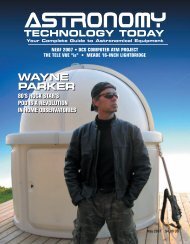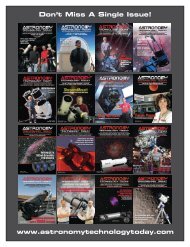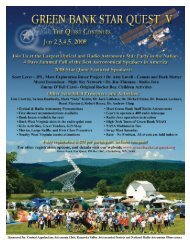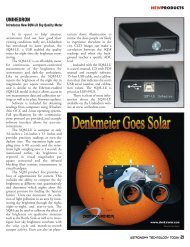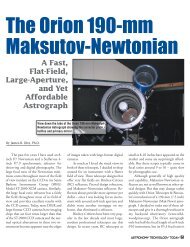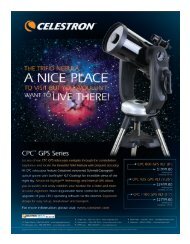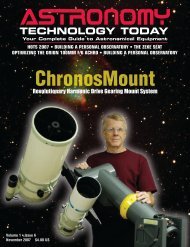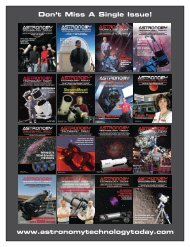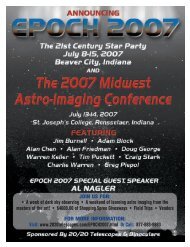Van Slyke Cover Article.e$S:Layout 1 - Astronomy Technology Today
Van Slyke Cover Article.e$S:Layout 1 - Astronomy Technology Today
Van Slyke Cover Article.e$S:Layout 1 - Astronomy Technology Today
You also want an ePaper? Increase the reach of your titles
YUMPU automatically turns print PDFs into web optimized ePapers that Google loves.
BFO in its heyday. A variety of portable scopes were used<br />
to view many celestial objects at once during evening<br />
sky tours and for portable deployment at schools, etc.<br />
By Paul B. <strong>Van</strong> <strong>Slyke</strong><br />
What Came Before<br />
When asked to write this article, I was<br />
hesitant because I’ve always believed that a low<br />
profile was in the best interest of my business<br />
and a quality product sells itself, without all the<br />
hype. That may sound counter-productive,<br />
from a capitalist perspective, and deserves further<br />
explanation. Perhaps a future article will<br />
include more about VSI products and my<br />
unique philosophy.<br />
I decided to accept ATT’s offer of this<br />
space because of two subjects I’ve been passionate<br />
about all my life: amateur telescope<br />
making and encouraging informed pro-space<br />
citizens. Applied properly, the former can be<br />
an exponential catalyst for the latter. The VSI<br />
website contains a slightly dated, but still topical<br />
article written about two decades ago and<br />
titled Why Space, for those who might share<br />
my adamant views on this astronomical subject<br />
(www.observatory.org/whyspace.htm).<br />
Many years ago, the “premier” astronomy<br />
magazine asked me for an article on the Black<br />
Forest Observatory (BFO). In my youthful exuberance<br />
(and ignorance), I jumped at the<br />
offer. To make a long story short, they sat on<br />
the article and never published it. Evidently,<br />
my viewpoint had a slant they considered inappropriate<br />
or simply did not support. I will<br />
not speculate on their agenda, but know that<br />
every person/organization has one, whether<br />
they know it or not.<br />
The following is not the identical unpublished<br />
article from long ago, but it does touch<br />
on the subjects others were [then] afraid to<br />
publish, and may still be? Unfortunately, the<br />
more things change, the more they stay the<br />
same, so I must [still] offer an abridged version<br />
with a more subtle persuasion. Before I tell the<br />
revised version of the story, an overview of<br />
BFO’s construction and equipment is provided,<br />
because that is what BFO was, and ATT<br />
is all about - telescopes and the associated<br />
equipment.<br />
The Facility<br />
Colorado’s largest observatory existed<br />
from 1986 to 2001. BFO, with its 18-foot<br />
dome and 30-inch Cassegrain, was not created<br />
for research. It was established to create a byproduct,<br />
[what I call] pro-space citizens. It was<br />
cut short by my need to eat and maintain a<br />
roof over my head - BFO was a non-profit in<br />
all aspects, especially for me. All I received<br />
from the endeavor was a giant honkin’ telescope<br />
which, in itself, could not sustain my existence.<br />
Thus, BFO finally gave way to the<br />
for-profit business, <strong>Van</strong> <strong>Slyke</strong> Instruments<br />
(VSI), but that is another story for another<br />
time. However, in its “heyday,” tens of thousands<br />
of people experienced the night sky during<br />
BFO’s short 15-year tenure.<br />
Although BFO was somewhat antiquated<br />
<strong>Astronomy</strong> TECHNOLOGY TODAY 33
BLACK FOREST OBSERVATORY<br />
BFO's warmroom/control center.<br />
by today’s standards, it did have all the expected<br />
“pomp and glitter” of Star Wars, Stargate,<br />
and all the sci-fi genre that people have<br />
come to expect from a [then] fairly sophisticated<br />
facility. To be honest, most of those rack<br />
mounts, monitors, oscilloscopes, microfiche<br />
rear projectors (Palomar Sky Survey, etc.), joysticks,<br />
lights, gauges and switches were nothing<br />
but “eye candy” for the public, emulating the<br />
vacuity of the Stargate stage sets. However,<br />
much of that seemingly superfluous equipment<br />
did actually serve a practical function in<br />
the operation of the facility. Our three desktop<br />
computers each contributed significantly,<br />
although only one of them actually controlled<br />
the positioning of the dome and telescope. The<br />
remaining two were for general reference, sky<br />
charts, etc.<br />
This story is also about the rambling and<br />
reminiscent memories of what has become a<br />
literal dinosaur - the Amateur Telescope Maker<br />
(ATM): that miniscule minority who would<br />
rather build a telescope than look, or image<br />
Get Yours<br />
<strong>Today</strong>!<br />
through it. The mainstream amateur astronomy<br />
community no longer designs and builds<br />
its telescopes from society’s discards, as it once<br />
did. The typical amateur today buys a go-to<br />
mount, a tube assembly and a CCD camera.<br />
We attach the mount to the floor of a suitable<br />
structure, the tube assembly to the mount, and<br />
insert a CCD camera in the hole in the back of<br />
the scope, enjoy a long gloat period, and flaunt<br />
our images to the world. How many of today’s<br />
amateur astronomer actually built that scope?<br />
Instead, a few very expensive parts are assembled.<br />
The ATM is dead. Long live the ATM.<br />
But I am not here to evaluate today’s amateur<br />
astronomer. With apologies to those who, like<br />
me, produce those high quality and relatively<br />
expensive parts, I am here, in part, to try and<br />
rejuvenate the wonderful hobby of telescope<br />
making by reflecting (pun intended) on my<br />
story of what was, and could be again.<br />
If you have no interest in building a telescope,<br />
the following will only be of passing curiosity.<br />
Hopefully it will be an interesting<br />
Let us custom build you<br />
the best, strongest, most<br />
well constructed scope<br />
transport case available!<br />
www.scopeguard.com<br />
“read,” if nothing else. However, if you would<br />
like to build a telescope from the ground up,<br />
and would really enjoy more than a modicum<br />
of satisfaction from this accomplishment, you<br />
may help to reignite that dying spark known as<br />
the ATM. Of course, if you really want to purchase<br />
your Meade/Celestron/etc. telescope and<br />
just look through it for all eternity, at all eternity,<br />
I’ve no objection. We truly need amateur<br />
astronomers to support the community of<br />
businesses and people, yours truly included,<br />
who try to make a living from the mechanically<br />
challenged or disinterested.<br />
The Observatory<br />
Large commercial domes are expensive!<br />
That said, building your own from scratch,<br />
while a daunting task, can save much of your<br />
bankroll for the scope. You may say, “A rolloff-roof<br />
is simple, easy and adequate.” True,<br />
but it’s not as publicly acceptable or consistent<br />
with expectations as a domed observatory. People<br />
expect Mount Palomar, the Keck Twins, or<br />
better when they come to experience your observatory.<br />
Nothing less will satisfy! Comments<br />
from those who visited BFO ranged from,<br />
“This isn’t the Mount Palomar I expected…”<br />
to, “I was expecting a hut in the woods, and<br />
this is a real domed observatory. Impressive!”<br />
The dome was built by “world renown”<br />
mirror maker, Alan Raycraft, with very little<br />
[occasional] help from me. The base ring and<br />
ribs were formed from 1/2-inch plywood cut<br />
into circular hemispheres, by hand, using a jigsaw.<br />
The sectional flats were glued together,<br />
using construction adhesive, to form a rigid<br />
continuous frame structure. Yeah, I know what<br />
you’re thinking, “That’s a lot of time and tedious<br />
work!” But, remember what I suggested<br />
before, “It’s not the effort, it’s the continuing<br />
journey.”<br />
The gores were cut from 1/8-inch tempered<br />
Masonite, screwed and glued to the<br />
skeleton frame using construction adhesive. A<br />
conventional center split, bi-directional shutter<br />
was selected and built to take advantage of esthetics<br />
- a timeless symmetrical design. Long<br />
aluminum C-channel sections were built into<br />
the dome and dolly-type wheels were attached<br />
to the two shutter sections to provide easy<br />
34 <strong>Astronomy</strong> TECHNOLOGY TODAY
BLACK FOREST OBSERVATORY<br />
Alan Raycraft and Paul <strong>Van</strong> <strong>Slyke</strong> building the skeleton frame for<br />
BFO’s 18-foot dome.<br />
Local astronomy club members help move the dome from its construction<br />
site to the observatory (looking like a giant white, multilegged bug).<br />
opening and closing.<br />
The dome was lifted onto the square base<br />
structure with a large construction crane. Sixteen<br />
6-inch diameter metal wheels were attached<br />
to the square building. Two of the<br />
wheels were used in tandem, creating railroadtype<br />
wheel sets. In other words, two of the<br />
wheels were mounted on a central seesaw<br />
pivot, like a flotation arm, that applies even<br />
pressure between two of the wheels on the<br />
dome’s lower base ring. There is a materials<br />
conflict that must be noted. Metal wheels<br />
make it much easier to rotate the dome, but<br />
the metal wheels will eventually shred the plywood<br />
base ring. Using hard rubber wheels will<br />
make it much harder to rotate the dome, but<br />
the plywood laminate will not shred. My best<br />
solution was to have an 18-foot diameter, sectional<br />
sheet metal base ring made at a local<br />
sheet metal shop and attach it to the bottom of<br />
the dome’s base ring using wood or sheet metal<br />
screws. Use at least an 8 gage (1/8-inch thickness)<br />
sheet metal or the sheet metal will also<br />
eventually shred.<br />
After initial installation, the dome was rotated,<br />
by hand, using a long rope with many<br />
“volunteers” attached to the end. Watching<br />
them rotate the dome reminded me of the<br />
Egyptian slaves moving those massive stones<br />
with simple ropes and brute force…with appropriate<br />
music - possibly the March of the<br />
Slaves by Tchaikovsky. Usually I was the<br />
marcher, not the watcher. Eventually the dome<br />
rotation was motorized along with the shutters.<br />
A box-like bracket plate was used to<br />
mount the 1/2-HP reversible AC motor, a<br />
50:1 worm-gear reducer and a chain and<br />
sprocket turning a shaft, with a golf cart tire<br />
attached to the end and pressing against the<br />
dome’s lower base ring. I know it doesn’t sound<br />
like it would apply enough force/torque to rotate<br />
the dome, but it worked flawlessly for 15<br />
years with very little maintenance, even in<br />
heavy snow and ice conditions. The shutters<br />
were also motorized using two gear reduced<br />
Bodine AC reversible motors and an independent<br />
cable/pulley at each end of the shutters.<br />
If the shutter’s cables ever slipped, the<br />
motors could be individually reversed to resync<br />
the shutters.<br />
The Telescope<br />
I do not consider pushing your own glass<br />
a prerequisite to earning the title of ATM.<br />
Some may disagree. Mirror making, especially<br />
a large one, is a singular art requiring a tenacious<br />
disposition and the patience of a monk<br />
on a crusade. I have the utmost respect and admiration<br />
for the ATM who not only builds his<br />
telescope from scratch, but also grinds his own<br />
<strong>Astronomy</strong> TECHNOLOGY TODAY 35
BLACK FOREST OBSERVATORY<br />
Spider and motorized secondary hub.<br />
mirror. However, building your own telescope,<br />
less the optics, requires enough skill to keep<br />
most of us, including myself, busy for a very<br />
long time.<br />
I personally believe that a telescope should<br />
not be built out of wood. Wood is for furniture.<br />
I’m going to get a lot of flack for this<br />
comment, but I think there is a lot of repressed<br />
support for this philosophy. I’ve built more telescopes<br />
in my life than I can remember, and<br />
they have all been metal. No Dobs and no<br />
alt/az mounts, because they could not track.<br />
Of course, nowadays many Dobs and alt/az<br />
RA axis with 20-inch Byers drive and<br />
3-motor drives.<br />
mounts track well via computer control.<br />
All my ATM telescopes were reverse engineered<br />
from society’s discards. Yes, all of<br />
them were metal, but they were fabricated<br />
from scrap metal - a shaft here, a tube there,<br />
etc. I would slow down when passing an old<br />
culvert lying beside the road - a possible telescope<br />
pier or tube? I’d spend all day at a local<br />
scrap metal yard, mind racing with endless<br />
possibilities. That was fun to me. I know, get a<br />
life! Do you need a fancy machining facility to<br />
shape these discarded metal structures to your<br />
needs? No, but a simple metal lathe and a<br />
Dec axis with 12-inch Mathis drive and<br />
3-motor drives.<br />
welder helps. However, my early telescope fabricating<br />
tools consisted largely of a bunch of<br />
files, hacksaw, and a hand drill.<br />
BFO’s 30-inch, f/9 Dall-Kirkham<br />
Cassegrain optics were fabricated, to my specifications,<br />
at a commercial facility in Utah. The<br />
30-inch, f/3 primary mirror was mounted in<br />
an 18-point flotation cell and the 12-inch secondary<br />
mirror was mounted in a spider assembly<br />
that provided a full 3 feet of back focus<br />
range with the push of a button. To clarify,<br />
moving the motorized secondary in or out<br />
from the primary changed back focus by a<br />
36 <strong>Astronomy</strong> TECHNOLOGY TODAY
BLACK FOREST OBSERVATORY<br />
The dome rotation motor and mechanisms.<br />
The 30-inch Cassegrain primary and secondary mirrors before<br />
installation in the tube assembly.<br />
ratio of approximately 6 to 1. One inch of distance<br />
separation related to 6 inches of back<br />
focus change. Of course, this is a "rule-ofthumb"<br />
ratio. The primary mirror cell was<br />
heavy die-spring loaded and collimation was<br />
achieved by turning three large hand wheels.<br />
The helical, non-rotating motorized spider was<br />
stepper motor controlled and both were fabricated,<br />
from scratch, at my machine facility.<br />
The scope's visual back, which also doubled<br />
as the flotation system for the primary<br />
mirror, had a motorized 3-inch rack and pinion/Crayford<br />
custom designed focuser docked<br />
to it, providing a [front/rear] dual focusing capability.<br />
It was actually the prototype for a future<br />
focuser that would be called the VSI Super<br />
Power Focuser (SPF) - an R&P/Crayford hybrid.<br />
This early design finally gave way to a<br />
pure Crayford design that many of you may<br />
remember as the Monster Focuser, now also<br />
discontinued.<br />
I believe that a versatile scope should have<br />
secondary mirror [primary]<br />
focusing with a<br />
large secondary focuser<br />
docked to the visual<br />
back. In other words, a<br />
scope with only one focusing<br />
capability loses a<br />
lot of functionality, especially<br />
if you do visual<br />
and imaging with the<br />
same telescope. A significant<br />
change in back<br />
focus, say shortening<br />
your imaging train<br />
profile to accommodate<br />
a shorter<br />
visual/eyepiece profile,<br />
is much more convenient<br />
when you have<br />
dual focusing capability.<br />
The 3-foot diameter<br />
tube assembly was<br />
rolled from a 1/8-inch<br />
thick anodized aluminum<br />
sheet and simply<br />
held together at the<br />
seam using sheet metal<br />
screws. An internal ribbing structure served a<br />
dual purpose: providing structural stability and<br />
internal light baffling. Two stability trusses<br />
were attached to the front of the tube cradle<br />
and extended to the front of the tube assembly.<br />
Many ATMs build a telescope without considering<br />
the importance of primary mirror and<br />
tube internal diameter clearance. Even a truss<br />
tube can be affected by these parameters. I use<br />
another "rule of thumb" measurement for determining<br />
this clearance, which is 12 to 1. If<br />
you have a 12-inch diameter primary mirror,<br />
you need 1-inch of tube clearance between<br />
your mirror and your tube. A 36-inch scope<br />
would require 3 inches around its tube. These<br />
clearances are minimum - any less and tube<br />
currents will radiate into your parallel incoming<br />
light cone and deteriorate imaging quality.<br />
I've always preferred German equatorial<br />
mounts, but only if they are permanently<br />
mounted - counterweights can be heavy to<br />
transport. Except for the occasional mechanical<br />
flip-flop (crossing the meridian), an equatorial<br />
has no physical obstructions to deter<br />
pointing around the North Celestial Pole<br />
(NCP). Concerning fork mounted scopes, to<br />
me it is a "non-issue" to even consider it necessary<br />
to allow an imaging train to clear between<br />
your forks. I get this concern from so<br />
many people/clients who consider this an important<br />
factor that, when building an imaging<br />
train, they sacrifice much more important considerations<br />
just so the scope can point to the<br />
NCP unobstructed by the fork. Why? There<br />
are so few NCP celestial objects that would<br />
OFFERS:<br />
SOLAR FILTERS • H ALPHA<br />
ECLIPSE VIEWERS • R-G SOLAR FILM<br />
DEW HEATERS • NEBULA FILTERS<br />
www.ThousandOaksOptical.com<br />
<strong>Astronomy</strong> TECHNOLOGY TODAY 37
BLACK FOREST OBSERVATORY<br />
The dome was loaded on the flatbed trailer before it was destroyed<br />
on I-25. Also shown is the crane that lifted the dome off the building.<br />
cause this conflict, that to even consider it a<br />
problem is obsessive-compulsive at best.<br />
The BFO mount, from the ground up,<br />
started with a reinforced concrete isolation<br />
platform, 3 feet in diameter and set about 5<br />
feet into the ground. A 3-foot diameter cardboard<br />
Sonotube worked great. A 4-inch<br />
ABS/PVC conduit was installed down the center<br />
and through the sidewall of the cardboard<br />
tube going to the warm-room. I found an old<br />
14-inch cast-iron sewer pipe about 4 feet long<br />
with a [12-bolt pattern] flange on one end for<br />
the pier, and it was free, discarded in a construction<br />
site. The wall thickness was a more<br />
than adequate 3/4 of an inch.<br />
The German equatorial mount was designed<br />
and created at a machine shop facility to<br />
which I was assigned at the time and primarily<br />
from pieces found in the scrap metal yard<br />
of that facility. The RA shaft was machined<br />
from a 3.5-inch diameter, solid steel shaft, fitted<br />
with 6-inch radial ball-bearings. The Dec<br />
shaft was a salvaged stainless steel control rod<br />
drive that was originally destined for a nuclear<br />
power plant, but was rejected. It was not radio<br />
active - important point!<br />
The RA shaft was equipped with a 20-<br />
inch Byers gear with a stainless steel worm and<br />
the Dec shaft was equipped with a 12-inch<br />
Mathis drive. The 12-inch Mathis drive was a<br />
little undersized, but, as noted before, when<br />
you are scrounging for parts, they are not always<br />
a perfect fit for the application. The<br />
worms were connected<br />
to three independent<br />
motor drive systems: a<br />
synchronous motor for<br />
simple tracking, a pair<br />
of stepper motors for<br />
tracking and variable<br />
speed slow motion<br />
control for pushbutton<br />
centering of objects in<br />
the field of view, and a<br />
pair of matched DC<br />
servo motors with<br />
tachometer feedback<br />
and closed-loop digital<br />
IC velocity controllers<br />
with ramping that provided<br />
tracking, slow motion and fast slewing<br />
with 5 inch-pounds of torque from 3 to 5000<br />
rpm. All three motor systems were mechanically<br />
connected via cog pulleys and belts to a<br />
common shaft that drove the worm gears in<br />
both axes. The stepper motor and the DC<br />
servo motor shafts rotated freely when off, and<br />
the synchronous motor had an automatic<br />
built-in magnetic clutch that disengaged the<br />
motor shaft when not running, so there were<br />
no motor engaging conflicts along the common<br />
motor shaft. When possible, I have always<br />
preferred to build redundant versatility<br />
into my scopes.<br />
Scope movement and positioning were<br />
available from a hand paddle at the scope, a<br />
joystick controller platform in the warm-room,<br />
or by computer. All three motor control systems<br />
were available at each control station -<br />
again, redundant versatility. The acronym for<br />
the computer control positioning and dome<br />
sync was “OTIS” (Observatory Telescope Interface<br />
System). A friend and I wrote the program<br />
in Basic Pro v4. After many code<br />
changes, we finally achieved a final operating<br />
version and compiled the open code. It worked<br />
well for years, but the software and hardware<br />
interface was built as a one-off proprietary system<br />
that was specifically designed for the DC<br />
servo motors and controllers that I acquired at<br />
a local electronics surplus store. These hardware<br />
motor controllers were surprisingly adequate,<br />
considering they were never actually<br />
designed to be computer interfaced in the first<br />
place.<br />
The End of BFO<br />
BFO’s 30-inch scope and 18-foot dome<br />
were sold, long after <strong>Van</strong> <strong>Slyke</strong> Instruments<br />
had become a viable business. I eventually decided<br />
that I am only one person and VSI alone<br />
had become a virtual 3-man operation: me,<br />
myself and I. It was difficult to make a decision<br />
to liquidate an effort that consumed 15<br />
years of my life. What really helped me accept<br />
the loss was my mental and physical condition<br />
at the time. I was totally exhausted from years<br />
of trying to maintain both businesses myself.<br />
At the time, the end of BFO was a relief.<br />
The scope was sold, dismantled and carefully<br />
packed in the buyer's truck. It is becoming<br />
operational again at a much better location<br />
at an elevation of over 9000 feet on the west<br />
side of Pikes Peak, still in Colorado. The dome<br />
was a different story. When the dome was<br />
lifted off the observatory building, it was split<br />
in two half hemispheres (it was designed that<br />
way) and loaded on a flatbed semi-trailer for<br />
its journey south. On its way down I-25, the<br />
dome sections caught a good head wind and<br />
[both] were launched off the back of the semi,<br />
tumbling down the middle of the freeway.<br />
Needless to say, they were demolished. Small<br />
pieces of dome were scattered along the highway<br />
for miles. The highway patrol was not<br />
happy with the mess either. Luckily, the dome<br />
was insured and no one injured.<br />
Of course the big hole in the center of the<br />
remaining building was a problem, so I had a<br />
framing crew build a pitched truss roof on the<br />
structure making the building whole again.<br />
My wife and I installed a nice drop ceiling,<br />
with lighting, and the old BFO is once again<br />
a viable structure supporting VSI. The lower<br />
building structure is now VSI's new office,<br />
shipping and receiving, storage and product<br />
warehouse.<br />
BFO's Educational<br />
Space Mission<br />
To return to our opening commentary<br />
and space, BFO's educational mission was to<br />
encourage pro-space citizens - to promote<br />
38 <strong>Astronomy</strong> TECHNOLOGY TODAY
BLACK FOREST OBSERVATORY<br />
After BFO. VSI's new office, etc.<br />
space exploration by sharing a sense of personal<br />
connection to space. Our sky tours were offered<br />
to all, from school children to senior<br />
groups. We also traveled to schools with telescopes<br />
offering daytime solar programs and<br />
provided accredited in-service courses to K-12<br />
teachers with hands-on telescope experience. I<br />
even taught astronomy at the University<br />
of Colorado under an honorary teaching<br />
position.<br />
Initially, my most difficult challenge was<br />
how to overcome cloudy nights at the observatory.<br />
Eventually, I found an effective strategy<br />
for parting the clouds, both day and night.<br />
Was it divine intervention? No, just practical<br />
application and some techno-magic. Scheduled<br />
sessions were never weather dependent<br />
after this epiphany: I simply installed a small 2-<br />
inch monitor at the focus point of the eyepiece,<br />
and connected it to the 30-inch<br />
telescope like a regular eyepiece. At first, I<br />
didn’t think the plan would work, as children<br />
are not easily excited or impressed. We didn’t<br />
try to fool them into thinking it was the real<br />
thing in real time, but visitors were able to step<br />
up to the eyepiece, look “through the telescope,”<br />
and see whatever the computer wanted<br />
them to see. Turned out, everyone loved the<br />
idea. Even though they knew it wasn’t “real,” it<br />
provided a hands-on and engaging experience.<br />
The above, and other observatory “magic,” was<br />
designed to provide the sense of connection to<br />
space necessary to creating those pro-space citizens,<br />
not from sci-fi special effects magic, but<br />
from real magic - the catalyst created from<br />
knowledge and truth.<br />
The extended “space mission” of BFO<br />
was to provide a meaningful context for public<br />
consideration of issues relating to our connection<br />
with space (again, see Why Space for<br />
more) - for consideration of such questions as:<br />
Did our government mistake the wishes of<br />
[now] almost two generations of planet earth<br />
dwellers? Oh, we returned to space, but why<br />
did we need to return to anything? Why did<br />
we ever leave in the first place? After Apollo,<br />
the shuttle was developed, but its initial charter<br />
was to deploy dozens of military spy satellites<br />
to orbit before NASA could even begin to<br />
do any pure science and to develop space. Was<br />
NASA’s peaceful, scientific development of<br />
space deferred by the military? After all, the<br />
military had their own independent rocket<br />
program and could put spy satellites into orbit<br />
all day long. Was it governmental “bean<br />
counter” strategy that forestalled human exploration<br />
of space? Were our representatives,<br />
from both parties, appropriately considering<br />
our long-term space interests? And finally, did<br />
we needlessly spend over a billion NASA dollars<br />
just to find out that the space plane wouldn’t<br />
work? Is our Constellation space program<br />
going “back to the future” simply by readopting<br />
Apollo-like applications? Obviously, I have<br />
definite opinions on these matters, but offer<br />
these questions to better explain the range of<br />
bigger-than-Earth issues BFO was designed to<br />
encourage the consideration of, regardless of<br />
individual conclusions reached.<br />
My rhetorical questions are meant to be<br />
constructive, not to criticize or “point fingers”<br />
at anyone or any single organization. Nor are<br />
they intended as partisan. I simply maintain<br />
that, as a species, we can’t afford many more<br />
30-year delays in our space efforts. We may<br />
outgrow our home planet before it happens,<br />
but most of us who study astronomy know<br />
that the habitable “lifespan” of this planet is finite.<br />
However, the universe is, by comparison,<br />
infinite, with every star potentially orbited by<br />
habitable planets - there are enough extra-solar<br />
rocks out there for each of us to have our own,<br />
if we’ll only go. Think large! Is this the appropriate<br />
“place” for this discussion? Probably not.<br />
But, I hope I am talking to a receptive choir?<br />
If you own a telescope, you have all the tools<br />
you need to encourage in others a meaningful<br />
and real connection to the cosmos - especially<br />
when you create those tools with your own<br />
two hands. “The planet is in your galaxy.”<br />
As always, thanks for your continued<br />
support!<br />
Eclipse Special Edition<br />
Red Illuminated<br />
Keyboard<br />
Only<br />
$49.99<br />
Plus Shipping and Handling<br />
FAR LABORATORIES<br />
WWW.FARLABORATORIES.COM • 800-336-9054<br />
<strong>Astronomy</strong> TECHNOLOGY TODAY 39



